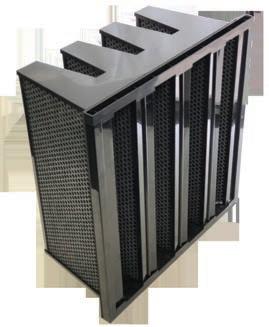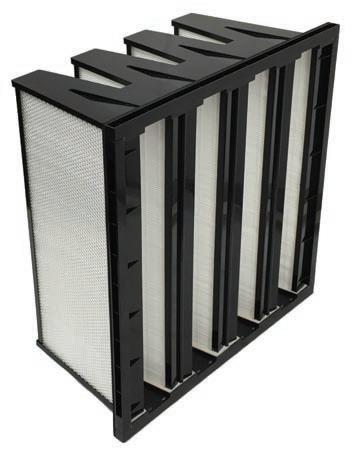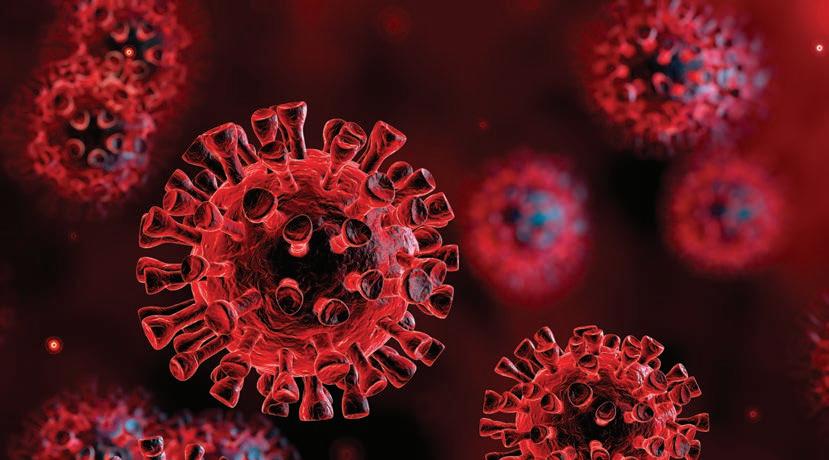
6 minute read
Bushfir e smoke & commercial buildings
Bushfire Smoke & Commercial Buildings
Jonathan Bunge (M.ENG Chemical) and Shannon Roger (B.Ed) I Airepure Australia 2020
Air filtration within commercial buildings typically includes both outside air and recirculated air handling systems to ensure air quality for building occupants. On days of poor air quality such as when bushfire smoke is present, the focus should be on improving air filtration of outside air handling systems (rather than recirculated air handling systems) to improve air quality for building occupants.
Commercial buildings are required to provide a constant flow of outside air to the inside of commercial buildings via outside air handling systems. If the air filters are not of a high enough efficiency to remove smoke particles, this will lead to a significant amount of smoke being noticed inside buildings.
Smoke is one of the most difficult particles sizes to catch as it is 0.3 - 0.5 microns in size.
Smoke fits within the PM2.5 category (which are particles with a diameter of 2.5 micrometres or less). These particles are so small they can get deep into the lungs and into the bloodstream, affecting the heart and lungs and potentially causing serious health effects.
Odour Filters Bushfires produce smoke particles, which can be removed from the air stream within commercial HVAC systems using appropriately efficiency rated particulate air filters – which target and capture the smoke particles. Refer to table below.
In addition to smoke, bushfires also produce odourous gases such as oxides of nitrogen (NOx) and volatile organic compounds (VOC). These odourous gases are often bound to smoke particles, which means that a significant amount of them can be removed along with the smoke with effective particulate filtration.
To eliminate the presence of bushfire smoke and odour within commercial buildings via existing HVAC systems, an
upgrade of the particulate air filters within outside air handling systems is the most important factor, followed by the addition of gaseous (carbon) filters.
The particulate air filters (of appropriate efficiency) will capture the majority of the smoke particles and the odour attached to the smoke particles. This will improve air quality for building occupants. The addition of the gaseous filters placed after the particulate air filters will adsorb the remaining odourous gases.
Please Note: A gaseous (carbon) filter alone will not remove smoke particles. A particulate air filter (of appropriate efficiency) is required to capture the majority of the smoke particles and the odour attached to the smoke particles.
To reduce the presence of bushfire smoke and odour within commercial buildings via existing HVAC systems, an
upgrade of the particulate air filters within outside air handling systems is the most important factor.
The particulate air filters (of appropriate efficiency) will capture the majority of the smoke particles and the odour attached to the smoke particles. This will improve air quality for building occupants. However, it is probable that some bushfire odour would remain.
Smoke (Particulate) Filtration


Table 1: Estimated Smoke Removal Efficiencies.
This table lists an estimated smoke removal efficiency for particulate air filters of different ratings.
A knowledgeable filter manufacturer or mechanical contractor should be able to assist with selecting the most suitable upgraded air filter that your existing HVAC system can handle.
Airepure recommends that E11 filters (EN1822 standard) are used within commercial building HVAC systems as they have an estimated 95-98% filtration efficiency for smoke particles at 0.3-0.5 microns.
It is important to note that due to increased resistance to airflow and space restrictions, this may not be practical for every commercial HVAC system.
Please Note: Upgrading particulate air filters will also result in:
Shorter air filter life Higher energy costs of air filtration A higher pressure drop that existing fans may not be able to handle.
The next best option is to select the highest-rated air filter your HVAC system can handle. Refer to table above.
You may consider holding spare particulate air filters of a higher efficiency that could be used for short periods when required – such as during poor air quality days or when bushfire smoke is present. The use of the higher efficiency spare filters may temporarily reduce airflow; however, this can be a useful short-term trade-off. The Air Pollution in Australia: Real-time Air Quality Index Visual Map - http://aqicn.org/map/australia/ is a valuable resource to monitor local air quality conditions.
Gaseous (Carbon) Filtration
The installation of a gaseous (carbon) filter in addition to the upgraded particulate filter will also help to eliminate odours associated with the bushfires within commercial buildings. This gaseous filter should be placed after the upgraded particulate air filter in the commercial HVAC system.
Airepure recommends a gaseous filter with a 50:50 blend of activated carbon media and permanganate impregnated activated alumina media as this will target the oxides of nitrogen (NOx), volatile organic compounds (VOC) and many other chemicals produced by the bushfires.
It is important to note that due to increased resistance to airflow and space restrictions, this may not be practical for every commercial HVAC system.
The next best option is to select a 100% activated carbon media filter, which will provide some improvement.
Please Note: A gaseous (carbon) filter alone will not remove smoke particles. A particulate air filter (of appropriate efficiency) is required to capture the majority of the smoke particles and the odour attached to the smoke particles.
Residential and Light-Medium Commercial Spaces
Large scale commercial buildings are considered to be “tightly sealed” in regards to infiltration of unfiltered outside air. In comparison, residential and light-medium commercial buildings are considered more “leaky”. Unfiltered outside air inherently flows through these spaces more easily through doors, windows, outside air vents etc. On days of poor air quality such as when bushfire smoke is present, it is generally more difficult to filter the outside air of these buildings simply because of the multiple, diverse sources of outside air.
If you have a ducted air-conditioning system, you should talk to your local mechanical contractor for advice re: upgrading the filtration in your existing air conditioning system.
If you have a wall split system air conditioner – the filtration for these systems cannot be upgraded to combat poor outside air quality. A portable in room air purifier may assist with improving the air quality of small sealed rooms – provided that outside air flow can be minimised to this area. It is important to check manufacturer guidelines regarding the effective range for performance and if any restrictions apply.
More Information
Further information on actions to take to combat smoke is in reputable sources such as below: https://www.abc. net.au/news/health/2019-11-19/bushfire-smoke-healthmanaging-risks/11699894 https://www.health.nsw.gov.au/environment/air/Pages/ bushfire-protection.aspx
About the Company
Airepure Australia
Airepure Australia is a leading national air filtration company providing unique, powerful and integrated air filtration solutions, ranging from basic HVAC filtration and odour control right through to high end HEPA/ULPA filtration and airborne containment technologies.
Recently acquired by global air filtration company Camfil, the Airepure team welcome this acquisition and the opportunity to combine the best of Airepure and Camfil’s people, products, services and custom engineered solutions to provide quality, purpose built clean air solutions for the Australian market.
For more information, visit www.airepure.com.au or call 1300 886 353.
PROPER AIR FILTRATION IS A NECESSITY IN REDUCING THE RISK OF INFECTION.

Air filters can remove the smallest particles from the air, reducing harmful airborne microbes, including cold and flu viruses, dust, pollen, mold spores and smoke particles. To learn more about protecting human health using air filters, visit camfil.com.au










